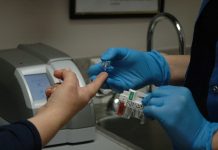August 2004 - Nearly a decade after the Department of Veterans Affairs initiated expansive improvements in how it cares for veterans with chronic illnesses, a new multicenter study finds VA patients with diabetes are more likely to receive recommended tests and have better outcomes than managed care patients.
Researchers looked at 1,285 patients with diabetes from five VA medical centers and 6,920 patients in eight commercial managed care health plans. They compared how often patients received standard processes of care, such as recommended tests, and their outcomes related to diabetes control.
The VA patients fared better than managed care patients on receiving appropriate care and on two of three outcomes, and in many cases the differences in quality were large.
The study will be published Aug. 17 in the Annals of Internal Medicine.
"A nationally funded health care system can provide excellent quality of care. The VA has instituted system-wide standards, integrated care, and a way to track and monitor how their patients are doing. Other organizations can learn from the VA and how they achieved their quality improvements over the last 10 years," says lead author Eve Kerr, M.D., M.P.H., a research scientist at the VA Ann Arbor Healthcare System and assistant professor of internal medicine at the University of Michigan Medical School.
Continue Reading Below ↓↓↓
For the study, researchers looked at whether patients received seven standard recommended tests or services: eye exam, hemoglobin A1c test (a measure of glucose control), cholesterol screening, foot exam, urine analysis, counseling on aspirin use and a flu vaccine. Researchers also checked whether patients fell within acceptable limits for blood pressure, cholesterol and hemoglobin A1c. Information was collected as part of the Translating Research into Action for Diabetes (TRIAD) initiative, a collaborative effort between the Centers of Disease Control and Prevention and the VA Research Service to evaluate the quality of diabetes care in commercial managed care organizations and in the VA.
Researchers found VA patients were more likely to receive each recommended screening or service:
* 93 percent of VA patients had an annual hemoglobin A1c test, compared to 83 percent of managed care patients; * 75 percent of VA patients were counseled about aspirin use, compared to 49 percent of managed care patients; * 91 percent of VA patients had an annual eye exam, compared to 75 percent of managed care patients; * 98 percent of VA patients had an annual foot exam, compared to 84 percent of managed care patients.VA patients also had their hemoglobin A1c and LDL cholesterol levels in better check. Blood pressure control was comparable for both sets of patients, with just over half having blood pressure levels 140/90 and even fewer below the stricter recommended levels.
Beginning in 1995, the VA instituted a series of quality improvements focused on managing chronic diseases, including diabetes. Many of the changes reflected recommendations subsequently promoted by the Institute of Medicine and treatment standards already used by some managed care organizations, such as performance monitoring, electronic medical records, disease management programs, patient reminders and automated feedback to doctors on quality of care.
"These results are encouraging because they demonstrate that optimizing how care is delivered can translate into clinical benefits for patients. However, we still need to learn more about which of the many changes the VA instituted improve quality the most, so that managed care health plans can implement these in the most cost effective manner," says senior author Carol M. Mangione, M.D., M.S.P.H., professor of medicine at the David Geffen School of Medicine at UCLA.
The managed care plans assessed in this study are among the best, with diabetes quality results near the top compared to all managed care plans accredited by the National Committee for Quality Assurance. Each commercial plan and VA medical center represents patients in a specific geographic area: Central Indiana, Northern California, Southern Texas, New Jersey and Pennsylvania, and Southeastern Michigan.
The study authors suggest that the VA's national system makes it easier to institute sweeping changes and to monitor whether those changes are making a difference in how patients get care, whereas managed care organizations are working individually with fewer resources and often must implement change one step at a time.
In addition to Kerr and Mangione, study authors were Sarah Krein, Ph.D., R.N., and John Piette, Ph.D., both from VA Ann Arbor Healthcare System and U-M Health System; William Herman, M.D., M.P.H., U-M Health System; Joseph Selby, M.D., M.P.H., Northern California Kaiser Permanente Division of Research; J. David Curb, M.D., M.P.H., Pacific Health Research Institute, Hawaii; David Marrero, Ph.D., Indiana University School of Medicine; Monica Safford, M.D., University of Medicine and Dentistry of New Jersey; and Robert Gerzoff, K.M. Venkat Narayan, M.D., and Theodore Thompson, all from the Centers for Disease Control and Prevention.
Funding was from the Department of Veterans Affairs, the Centers for Disease Control and Prevention, and the National Institute on Diabetes, Digestive and Kidney Diseases. Kerr was funded by a VA Advanced Research Career Development Award. The VA funding program had no role in the study design or data analysis.
Citation: Annals of Internal Medicine, Vol. 141, No. 4
Continue Reading Below ↓↓↓
Source: University of Michigan











